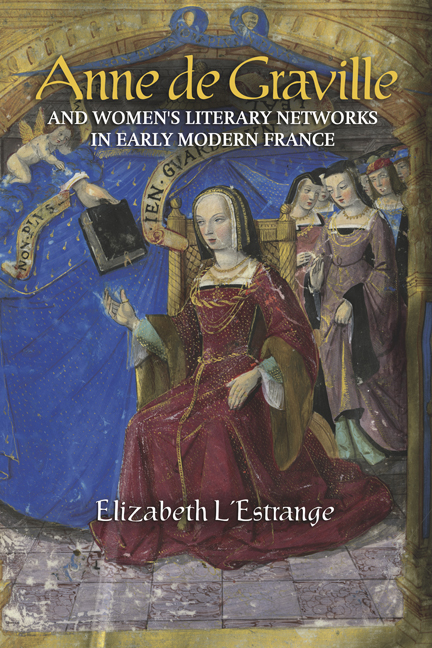Book contents
- Frontmatter
- Dedication
- Contents
- List of Illustrations
- Acknowledgements
- A Note on Citations, Translations and Transcriptions
- List of Abbreviations
- Map
- Introduction: ‘Une femme d’excellence en vertus, ma dame d’Entraigues’: Anne de Graville’s Life and Works
- PART I ANNE DE GRAVILLE: READER AND COLLECTOR
- PART II FROM READING TO WRITING: ANNE AS AUTHOR
- Conclusion: ‘Celle la qui porte le regnon’: A Last Word on Anne de Graville
- Appendix A Books Inherited, Acquired, Commissioned by or Associated with Anne de Graville
- Appendix B Inventory of the d’Urfé Library at La Bâtie, c. 1780
- Appendix C Manuscripts Containing Works by Anne de Graville
- Bibliography
- Index
- Gallica
Introduction: ‘Une femme d’excellence en vertus, ma dame d’Entraigues’: Anne de Graville’s Life and Works
Published online by Cambridge University Press: 11 January 2024
- Frontmatter
- Dedication
- Contents
- List of Illustrations
- Acknowledgements
- A Note on Citations, Translations and Transcriptions
- List of Abbreviations
- Map
- Introduction: ‘Une femme d’excellence en vertus, ma dame d’Entraigues’: Anne de Graville’s Life and Works
- PART I ANNE DE GRAVILLE: READER AND COLLECTOR
- PART II FROM READING TO WRITING: ANNE AS AUTHOR
- Conclusion: ‘Celle la qui porte le regnon’: A Last Word on Anne de Graville
- Appendix A Books Inherited, Acquired, Commissioned by or Associated with Anne de Graville
- Appendix B Inventory of the d’Urfé Library at La Bâtie, c. 1780
- Appendix C Manuscripts Containing Works by Anne de Graville
- Bibliography
- Index
- Gallica
Summary
Manuscript 5116 of the Bibliothèque de l’Arsenal in Paris opens with the words ‘C’est le beau romant des deux amants Palamon et Arcita et de la belle et saige Emilia translaté de vieil langaige et prose en nouveau et rime par mademoiselle Anne de Graville la Mallet, dame du Bois Malesherbes. Du commandement de la Royne (The fine story of the two lovers Palamon and Arcita and the beautiful and wise Emilia, translated from the old prose version into a new, rhymed one, by Lady Anne de Graville la Mallet, Dame du Bois Malesherbes, at the request of the queen) (fig. 1). This long title announces the genesis and authorship of the Beau roman– a reworking of the Livre de Thezeo, itself based on Boccaccio's Teseida– by the noblewoman Anne de Graville (c. 1490–1540) and its dedication to the queen, Claude of France (1499–1524), wife of Francis I (1494–1547). It is followed by a dedicatory prologue in which Anne de Graville addresses her ‘souveraine dame’ and the text continues on the verso, beneath a large miniature showing Claude seated on a throne draped in royal blue, under a canopy decorated with her arms of France and Brittany (fig. 2). Accompanied by a group of conversing ladies on her left, Claude turns towards Anne, who, soberly dressed in black, kneels on her right and humbly presents the queen with her work which she composed between 1521 and 1524. Whereas images of men presenting their works to women patrons are not unusual at the turn of the sixteenth century – for example, Jean Marot presenting his Voyage de Gênesto Claude's mother, Anne of Brittany (1477–1514) (fig. 3) – such images of woman-to-woman presentation are more unusual. Text and image on both sides of the Beau roman's opening folio nevertheless bear witness to women's literary activity at the French court as readers, patrons andwriters. The Arsenal miniature does, of course, have a precedent in a more famous example from one hundred years earlier, that of Christine de Pizan offering her collected works to another queen of France, Isabel of Bavaria (c. 1370–1435), surrounded by her ladies-in-waiting in the Queen's Manuscript(fig. 4).
- Type
- Chapter
- Information
- Publisher: Boydell & BrewerPrint publication year: 2023



